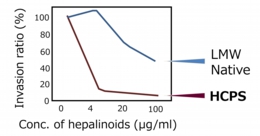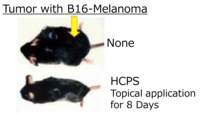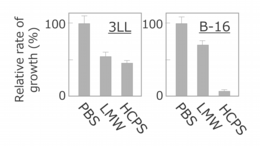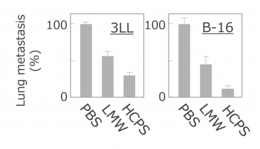It is supposed that HCPS is applicable to diseases involving surplus angiogenesis.
![]() Angiogenesis in tumor promotes its expansion.
Angiogenesis in tumor promotes its expansion.
- Feeding vessels are generated by angiogenetic factors arising from tumor cells.
- Supplying nourishment and oxygen from the generated vessels grows tumor.
- Metastasis occurs via the vessels.
![]() Retina injury involving surplus angiogenesis leads to losing sight.
Retina injury involving surplus angiogenesis leads to losing sight.
- Wet-AMD: age-related Macular Degeneration based on CNV (choroidal neovascularization)
- Diabetic Macular Edema (DME)
- Central retinal vein occlusion (CRVO)
Strategy of developing anticancer agent![]() Blockage of vascular endothelial growth factor (VEGF) from tumor
Blockage of vascular endothelial growth factor (VEGF) from tumor
 Monoclonal antibodies against VEGF/VEGF-Receptor
Monoclonal antibodies against VEGF/VEGF-Receptor VEGF receptor tyrosine kinase inhibitor
VEGF receptor tyrosine kinase inhibitor
![]() Blockage of tumor cell invasion through angiogenesis
Blockage of tumor cell invasion through angiogenesis
 MMP (Matrix metalloproteinase) inhibitor
MMP (Matrix metalloproteinase) inhibitor
![]() First priority as a drug
First priority as a drug
 Inhibit growth signal by Antibody/aptamer to VEGF (VEGF-R)
Inhibit growth signal by Antibody/aptamer to VEGF (VEGF-R)
Problem of the preceding angiogenesis inhibitors![]() Stable tumor cells become invasive and metastatic when the tumor is subjected to
Stable tumor cells become invasive and metastatic when the tumor is subjected to
BIBthe starvation state by inhibiting angiogenesis.
Cancer Cell. 2009; 15(3): 220–231. Antiangiogenic therapy elicits malignant
progression of tumors to increased local invasion and distant metastasis
Anticancer drug should have the inhibitory effect to metastasis
as well as angiogenesis.
Heparin binds various biomolecules described below.
(1) Growth factors (GFs), cytokines, chemokines
- GFs: VEGF, FGF-1, HGF, KGF, PDGF, HB-EGF, TGF, etc., Nutritional factors, Midkine, interferon, Interleukin, TNF-alfa, chemokine
Heparin suppresses the activities of
cytokines to promote metastasis,
as well as VEGF to promote angiogenesis.
(2) ECM: Extra cellular Matrix (the invasive target of tumor cells)
- Fibronectin, laminin, collagen, tenascin, thrombospondin
Heparin is combined with ECM, and then
blocks up tumor cell invasion and metastasis.
(3) Intercellular adhesion molecules (L-selectin、P-selectin、NCAM、PE-CAM)
Heparin is combined with the adhesion molecules,
and then inhibits to form tumors composed of
metastatic cells that have spread from the primary tumor.
(4) Virus, apolipoprotein, enzymes, a virus, protein derived from prion, annexin II, avidin, and so on.
Properties of heparin fits the strategy of antiangiogenesis and antimetastasis.
HCPS is a heparinoid to enhance the properties of heparin.
 HCPS inhibits metastasis that is caused by tumor cells invasion into proteoglycan.
HCPS inhibits metastasis that is caused by tumor cells invasion into proteoglycan.
- The graph shows that HCPS suppresses the invasion of tumor cells (3LL and B16) into proteoglycan of ECM.

 HCPS strongly suppresses binding of tumor cell to proteoglycan.
HCPS strongly suppresses binding of tumor cell to proteoglycan.

 Proteoglycan is an obstacle to metastasis based on tumor cell invasion.
Proteoglycan is an obstacle to metastasis based on tumor cell invasion. HCPS suppressed that cultured cancer cells adhere to proteoglycans and then IIIIinvade it.
HCPS suppressed that cultured cancer cells adhere to proteoglycans and then IIIIinvade it. These results indicate that HCPS has a strong antimetastatic effect for tumor cells.
These results indicate that HCPS has a strong antimetastatic effect for tumor cells.- Br J Cancer. 2002 June 5; 86(11): 1803–1812
Anti tumor effect of HCPS was proved in mouse tumor models.
- HCPS was administrated to the rats establishing model tumor, and then effectively inhibits tumor growth and suppresses metastasis.
![]() Inhibitory effect of tumor expansion
Inhibitory effect of tumor expansion
- The graph below indicates the inhibitory effects of HCPS against the expansion of two type model tumors.
![]() Inhibitory effect of metastasis
Inhibitory effect of metastasis
- The tumor cells were administrated from the tail vein of mice, and then examined metastases to the lung.
- It was observed that the metastasis of B-16 melanoma on the administration group is obviously suppressed.
- The graph below indicates the inhibitory effects of HCPS against the metastasis of two type model tumors.
- Br J Cancer. 2002 June 5; 86(11): 1803–1812




 Contact US
Contact US
